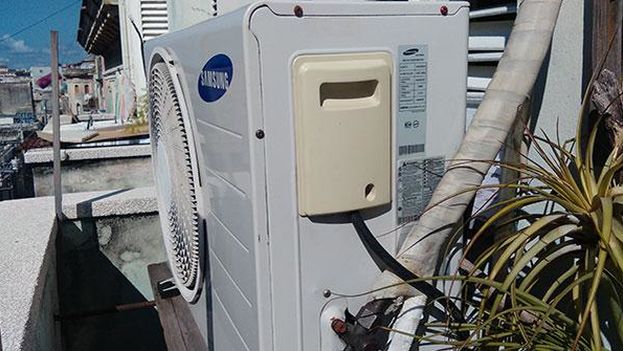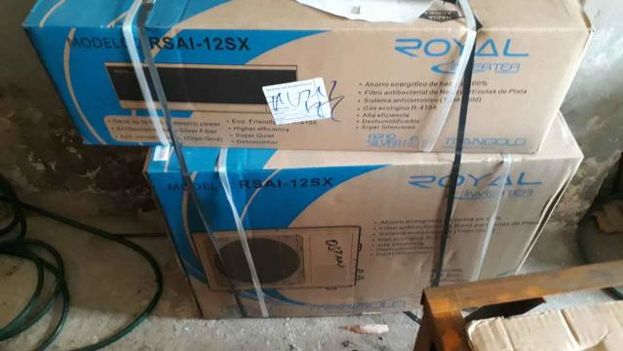
![]() 14ymedio, Zunilda Mata, Havana, 20 June 2017 — The passenger complains of the heat while frantically moving the fan. “In a few days I will install an air conditioning,” justifies the taxi driver and adds that he will charge “higher fares.” In summer everyone dreams of air-conditioning their rooms or vehicles, but whether or not one suffers the heat depends on the pocketbook.
14ymedio, Zunilda Mata, Havana, 20 June 2017 — The passenger complains of the heat while frantically moving the fan. “In a few days I will install an air conditioning,” justifies the taxi driver and adds that he will charge “higher fares.” In summer everyone dreams of air-conditioning their rooms or vehicles, but whether or not one suffers the heat depends on the pocketbook.
In 2013, after eight years of prohibition, the government authorized travelers to import air conditioners, electric stoves, refrigerators and microwave ovens. It was the starting shot for an avalanche that invades the airports, the port terminals and the shipping agencies to Cuba.
“Six ‘splits’ (air conditioners) came on that flight,” said an employee of Terminal 3 at José Martí International Airport in Havana. The plane from Cancun, a route greatly appreciated by the mules, also brought a dozen flat-screen TVs, eight minibars and two desktop computers.
Among the boxes that are piled around the luggage belt are the units that will be placed inside rooms and others that will be placed on a roof or an outer wall, a cruel irony, because in the main airport of the country travelers complain about the heat and drip fat beads of sweat while waiting for their suitcases.
“It is difficult to know the number of AC units entering each day,” says the employee. “It is rare that a flight arrives from Panama, Mexico or any other nearby country that comes without at least two devices.” In the lines to pay for overweight luggage and the import of domestic appliances one sees the new arrivals loaded with bundles.
Permanent residents in Cuba, national or foreign, can import two air conditioners of up to one-ton capacity on each trip. On the first occasion only – over the space of a year — they pay tariffs in Cuban pesos at a price ranging from 150 to 200 CUP (roughly $6 to $8 US). For additional imports they pay that amount in convertible pesos (CUC – roughly $150 to $200 US).
The business is booming. Even paying in CUC the traveler can resell a one-ton air conditioner on the black market for about 650 CUC, for a device that originally cost less than 350 dollars. The brands that enter most frequently are Midea, LG, Carrier, Royal, Daewoo and Prestiger. Prices have fallen by up to 30% since the imports were authorized and given the volume of supply that trend will continue.
State stores try to compete with the “under the counter” sales but have higher prices, fewer models and shortages that make the supply unstable.
The air conditioners have slowly been incorporated into the landscape of cities and towns. If before the economic relaxations they were installed discreetly, now with a more open economy the tendency is to exhibit them.
“The people living there have cash,” says Igor, a pedicab driver who waits for his clients in the vicinity of the Plaza de Carlos III. While pedaling and showing some parts of the city, the cyclist glances at these signs of families with money. “Wherever there is an air conditioner they are affluent,” he muses. Not only does acquiring one of these devices mark membership in a social group, the most difficult thing is to pay for its operation.
Much of the electricity supply remains subsidized. “The average monthly consumption in the residential sector in 2013 was approximately 180 KWh per customer,” said Marino Murillo. For that amount a consumer pays 36.60 CUP, “while the cost to the state is 220 CUP,” said Cuba’s vice president.
Keeping a one-ton air conditioner on all night can trigger electricity consumption above 400 CUP monthly, the entire salary of a professional. However, many families decide to do so, overwhelmed by the heat or because they want to rent rooms to foreigners.
“Air conditioning and hot water cannot be lacking in this business,” says Rocío, who operates a colonial hostel in Trinidad with his mother. With three rooms for rent, each with AC, minibar and television, the entrepreneurs pay a four-digit electricity bill. They consider that, even so, it “brings in business” in an area with a high occupation rate throughout the year.
In November 2010, a new progressive electricity rate began to be imposed, which imposes a penalty of up to 300% on households that consume more than 300 KWh per month, a situation that has triggered electricity fraud.
An engineer from the Electricity Company in Havana told 14ymedio about the new ways in which citizens seek to steal electricity. Before there were “visible” cables that were easy to detect or they tampered with the meters in a way that technicians noticed right away, but now they conspire with the workers who repair the streets and get the cables installed underground.

The specialist says that there are “people whose homes abut state entities and they steal electricity from a company, a warehouse, a carpentry workshop or even a polyclinic.” He says that almost always “it is a cases of people who have some highly customer-based business, like an electric oven to make pizzas, a body shop, a private restaurant or a lot of air conditioners.”
The engineer recalls a family in which “even the youngest children had AC in their room and left it on all day.” A neighbor reported the situation when he learned that they paid a very low electricity rate. The complaint brought the inspectors and they discovered that the meter was tampered with. In addition to the fine “they had to pay retroactively all that they owed.”
To counter fraud, analog meters were replaced by digital ones and in some areas of the country they are being changed again for new ones with infrared technology. But the tricks are inexhaustible.
“The upstairs neighbor lives alone and is retired, and he passes the cable with electricity to me and in return I also pay for his consumption,” says a prosperous entrepreneur who runs a coffee shop on Zanja Street. “So I share the consumption and it’s not as expensive” because it prevents all the kilowatts going on a single account with the consequent progressive surcharge.
The customer has three air conditioners installed throughout the house. “Without this you can not live here, because this house hardly has windows to the outside and the kitchen of the business generates a lot of heat,” he explains. He bought the devices in the informal market and is waiting for them “to lower prices a little” to buy a room.
“It is not the same to be Cuban with a fan as it is to be a Cuban with AC,” he reflects. “The first one is irritated but the second is less stressed because he has air conditioning.”
